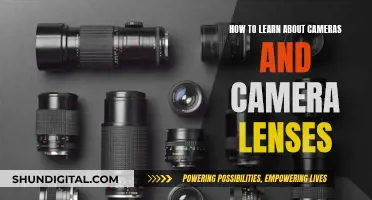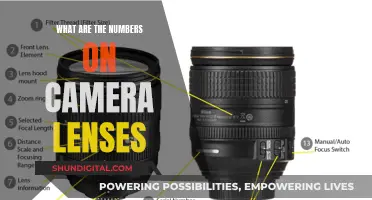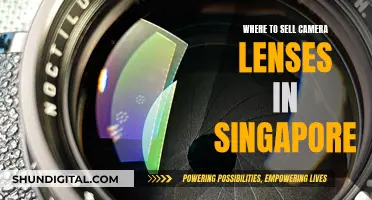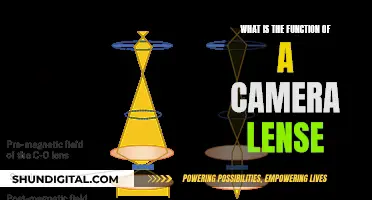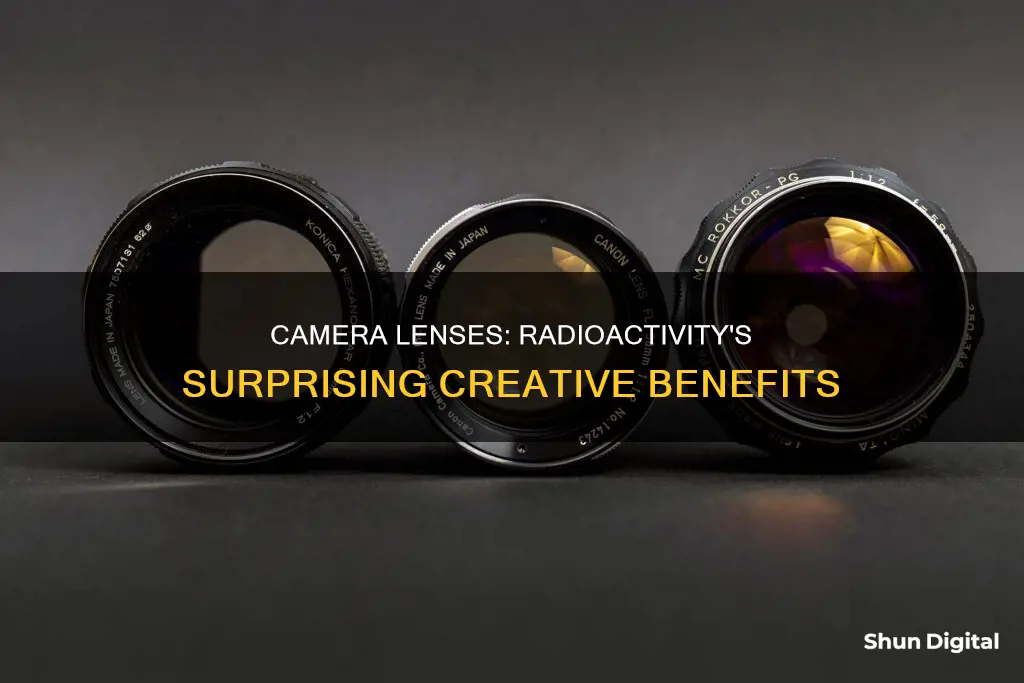
Many camera lenses produced from the 1940s to the 1980s are measurably radioactive. The radioactivity is due to the use of thorium oxide in the glass used in the lens elements. Thorium oxide has a crystalline structure similar to calcium fluoride (fluorite) and its optical properties of high refractivity and low dispersion allow lens designers to minimise chromatic aberration and use lenses of lower curvature, which are less expensive to produce.
The most prolific producer of radioactive lenses was Eastman Kodak. From the 1940s through the 1960s, substantial numbers of amateur cameras were produced and sold with thoriated lenses, including some of the Pony, Signet, and high-end Instamatic cameras. In addition, many professional-level Ektar lenses from this era contain thorium.
The use of thorium oxide in camera lenses ended in the 1980s due to consumer distaste for radioactive things and concern for factory workers.
| Characteristics | Values |
|---|---|
| Reason for radioactivity | The use of thorium oxide (up to 30% by weight) as a component of the glass used in the lens elements. |
| Period of production | 1940s to 1980s |
| Producers | Eastman Kodak, Canon, Konica, Asahi Pentax, and others |
| Models | Kodak Aero-Ektars, Canon FD 17mm f/4.0 SSC, Konica Hexanon AR 57mm f/1.2, and many others |
| Health concerns | Exposure to the eye to alpha and beta particles can cause cataracts and other problems. |
| Radiation levels | Approach 1 mR/hr as measured at the lens element's surface, decreasing substantially with distance. |
What You'll Learn
- Thorium oxide was added to lenses to achieve a high refractive index while maintaining low dispersion
- The addition of thorium oxide to lenses was pioneered by Kodak
- Lenses with thorium oxide have a yellowish tint
- Thorium oxide is radioactive and can be harmful to human health
- Radioactive lenses can cause digital cameras to produce image noise

Thorium oxide was added to lenses to achieve a high refractive index while maintaining low dispersion
Lenses with a high refractive index tend to also have high dispersion. However, thorium oxide can be added to the glass to achieve a high refractive index (over 1.6) while maintaining a low dispersion. This property is especially beneficial for making optical glass. The addition of thorium oxide to lenses allows lens designers to minimise chromatic aberration and use lenses of lower curvature, which are less expensive to produce.
Thorium oxide has a crystalline structure similar to calcium fluoride (fluorite). Fluorite also has optical properties of high refractivity and low dispersion.
Cracking Camera Lenses: A Step-by-Step Guide to Mastery
You may want to see also

The addition of thorium oxide to lenses was pioneered by Kodak
The inclusion of thorium oxide in the glass composition offers several benefits for lens designers. Thorium oxide has a crystalline structure similar to calcium fluoride (also known as fluorite), which exhibits desirable optical properties. By incorporating thorium oxide into the lens elements, designers can achieve high refractivity and low dispersion. This combination allows for the minimization of chromatic aberration and the use of lenses with lower curvature, resulting in reduced production costs.
Kodak produced some of the first radioactive lenses, notably the Aero-Ektar, which was used for aerial surveillance. From the 1940s to the 1960s, Kodak also manufactured and sold substantial numbers of amateur cameras equipped with "thoriated" lenses, including models from the Pony, Signet, and high-end Instamatic series. In addition, many professional-level Ektar lenses from this era contained thorium.
Over time, lenses containing thorium oxide may develop a brown tint due to the formation of F-centers in the glass caused by the radioactive decay of thorium. This discoloration can be reversed by exposing the lenses to bright light, UV light, or annealing the glass.
While Kodak was a prominent producer of radioactive lenses, other manufacturers such as Canon, Konica, and Asahi Pentax also utilized thorium in their lenses produced between approximately 1945 and 1980. However, by the early 1980s, the use of thoriated glass declined due to health concerns for factory workers and consumer radiophobia following nuclear accidents.
Camera Lenses: Do They Age Like Wine or Rust?
You may want to see also

Lenses with thorium oxide have a yellowish tint
The yellowish tint of thorium-coated lenses gives them a distinct look. However, the colour intensifies with time, turning the lens's "character" into something that's more of a nuisance. The yellow tint can be removed by using UV lighting. One method is to place the lens on a mirror and shine a UV light on it. The mirror will reflect UV rays through the lens. After around 10 hours, turn the lens over and leave it under the UV light for another 8-10 hours.
The yellowing of the lens can also be reversed by the action of photons (bright light). Exposure to bright light will bring the glass back to its natural clear state. Over the years, users of discoloured lenses have reported that exposure to sunlight, UV lamps, or bright LED lamps healed the yellowing.
Cleaning Camera Lenses: Removing Fungus and Mold
You may want to see also

Thorium oxide is radioactive and can be harmful to human health
Thorium oxide is a radioactive material that was once commonly used in the production of camera lenses. Its use in lenses can be harmful to human health, and it is important to understand the risks associated with its radioactivity.
Thorium oxide is a crystalline substance with optical properties that made it ideal for camera lenses. Its high refractivity and low dispersion allowed lens designers to minimise chromatic aberration and utilise lenses of lower curvature, resulting in cost savings during manufacturing. Due to these desirable properties, thorium oxide was utilised in the production of camera lenses from the 1940s through to the 1980s.
However, the radioactivity of thorium oxide poses health risks. It is a naturally occurring radioactive metal found in soil, rock, and water, formed by the decay of uranium. Exposure to thorium can occur through inhalation, ingestion, injection, or absorption through the skin. While most people are not exposed to dangerous levels, those living near thorium mining areas or facilities using thorium may have increased exposure, particularly if their water source is from a private well.
The health risks associated with thorium oxide include an increased risk of liver, lung, pancreatic, and bone cancers. Once injected into the body, thorium remains, resulting in long-term exposure. Additionally, the decay of thorium results in the emission of alpha, beta, and gamma radiation, which can cause damage to cells, particularly in the respiratory and digestive tracts.
To minimise the potential harm, it is crucial to avoid breaking or damaging lenses containing thorium oxide. While the radioactivity of these lenses is typically low, breaking them can release radioactive dust that can be inhaled or ingested, leading to internal exposure.
Overall, while thorium oxide was once a common component of camera lenses, its radioactivity and associated health risks have led to its discontinuation in lens manufacturing. It is important to handle these vintage lenses with care and take precautions to avoid exposure to their radioactive dust.
Camera Lenses: 3 Common Problems and Their Fixes
You may want to see also

Radioactive lenses can cause digital cameras to produce image noise
Many lenses produced from the 1940s to the 1980s are measurably radioactive. The main source of radioactivity is the use of thorium oxide (up to 30% by weight) as a component of the glass used in the lens elements. The addition of thorium oxide to the glass increases the refractive index while maintaining low dispersion. These properties are especially beneficial for making optical glass.
A high index of refraction means light travels slower within the glass, and therefore, changes its direction more easily. Lenses can have a lower profile, require less material, and thus be lighter. Low dispersion, defined by the Abbe number, allows lenses to correct chromatic aberration, ensuring the same focus is maintained throughout the whole range of colours in the visible spectrum, creating sharper images.
Combining these properties enables lenses with excellent optical performance. However, the use of thorium oxide in lenses can cause issues when used with modern digital cameras. The radiation emitted by the lenses can be detected by the camera's sensor, resulting in image noise.
Andrew Walker performed an experiment using a vintage Pentax SMC Takumar 50mm f/1.4 lens, which is known to be radioactive. He found that the rear element of the lens emitted radiation at a level of 24,000 counts per minute (CPM), which is around 650 times the level of background radiation. When used with a modern digital camera, the sensor picked up the radiation as visual noise. Over the course of 120 photos, the noise was visible and appeared as bright spots in the images.
Therefore, using vintage radioactive lenses can potentially ruin certain types of photography, such as long exposures or star-stacking. However, it is important to note that the noise may not always be present, and certain cameras may automatically reduce or eliminate the noise. Additionally, other more common types of photography are likely to be unaffected.
While the radiation emitted by these vintage lenses can cause image noise, it is important to note that the health risks associated with their use are relatively low. The radiation levels emitted by the lenses are typically not harmful unless exposed to them for extended periods.
The Camera Lens Location on the Note 10 Plus
You may want to see also
Frequently asked questions
Thorium and lanthanum, mainly. Camera lenses contain optical glass made with various unusual elements like lead, boron, calcium, lanthanum, and thorium dioxide. These elements have distinct optical properties, allowing manufacturers to create lenses of superior quality.
The addition of thorium oxide, or thoria, to the glass increases the refractive index while maintaining low dispersion. These properties are especially beneficial for making optical glass.
No, only some vintage lenses are radioactive.
The most reliable way to determine whether a lens is radioactive is by measuring it with a Geiger counter. However, if you don't have access to one, a visual inspection can also provide clues. Radioactive lenses often have a yellowish tint due to radiation-induced formation of colour centres in the glass matrix.
While the amount of radiation from these lenses is relatively low and they are considered safe for normal use, it is important to take some precautions. Avoid breaking the lens, as this can release radioactive dust that could be inhaled or ingested. Additionally, keep the lenses away from your body and avoid long-term exposure to minimise any potential health risks.



